Transient visitor levy: consultation
Views sought on the principles of a local discretionary transient visitor levy or tourist tax.
Annex A: Background to the Tourism Industry in Scotland
Tourism is a significant part of Scotland’s economy, in terms of its size, economic contribution, and its distribution across Scotland. This Annex provides an updated overview of tourism activity in Scotland, including trends in overnight visitor numbers and day visitors, and data on the accommodation sector.
Overnight Visitors
In 2018, Scotland received an estimated 15.3 million overnight visitors, an increase of around 0.5 million (3 per cent) since 2017. There were 11.8 million (77 per cent) domestic visitors (from within GB) and 3.5 million international visitors (23 per cent) in 2018.
Although overall overnight visitor numbers were similar in 2011 and 2018, there has been notable variation over the period. The number of international visitors has grown significantly significantly in recent years, with a 37 per cent increase compared to 2016, whilst the number of domestic visitors has fallen marginally by 2 per cent. Overall the proportion of international visitors made up 23 per cent of all visitors in 2018 compared with just 15 per cent of visitors in 2011.
Figure 1: Overnight Visitors to Scotland since 2011 (International and Domestic)
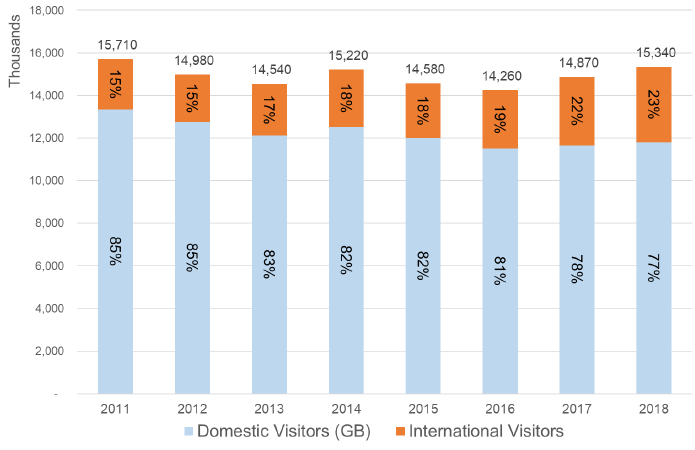
Source: IPS and GBTS (2019)
Figure 2 shows that over half (55 per cent) of overnight visitors to Scotland in 2018 visited for the purpose of a holiday, with 27 per cent visiting friends and family, 13 per cent visiting for business purposes and a further 3 per cent for other reasons. Compared to 2011, the number of visitors staying for the purpose of a holiday has risen, whilst the number of visitors visiting for business or visiting friends and family has fallen. The rise in holiday overnight visitors is again mainly driven by international visitors, with a 62 per cent growth in international visits for holiday purposes since 2011.
Figure 2: Overnight visitors (2011 and 2018) by purpose of visit
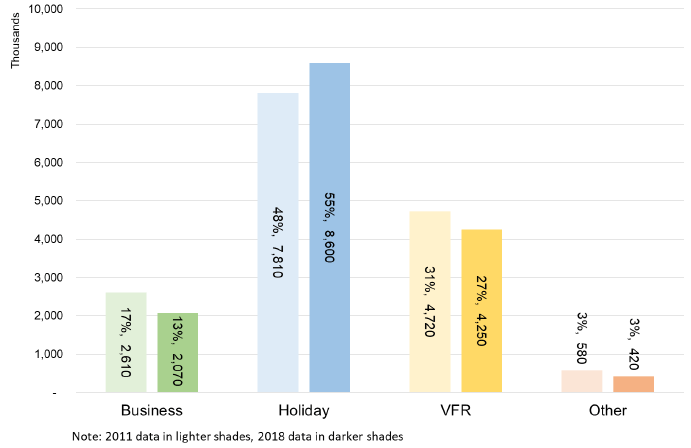
Source: IPS and GBTS (2019)
Figure 3 shows the distribution of overnight visits across Scotland in 2018[30], revealing significant regional concentrations of visitors. Edinburgh and the Lothians received over 5.2 million overnight visitors in 2018, 31 per cent of total overnight visitors to Scotland and an increase from 2017 where the total number of visits was below 5 million. Greater Glasgow & Clyde Valley and the Highland and Islands received similar numbers of overnight visitors overall with a 16 per cent (2.7 million) and 15 per cent (2.6 million) share of Scotland’s overnight visitors respectively. The Highlands & Islands had significantly more holiday visits (1.8 million) compared to Greater Glasgow & Clyde Valley (1.2 million) with the majority of visitors mainly coming to visit friends and family or on business.
Figure 3: Overnight Visitors by Region and Reason for Travel, 2018
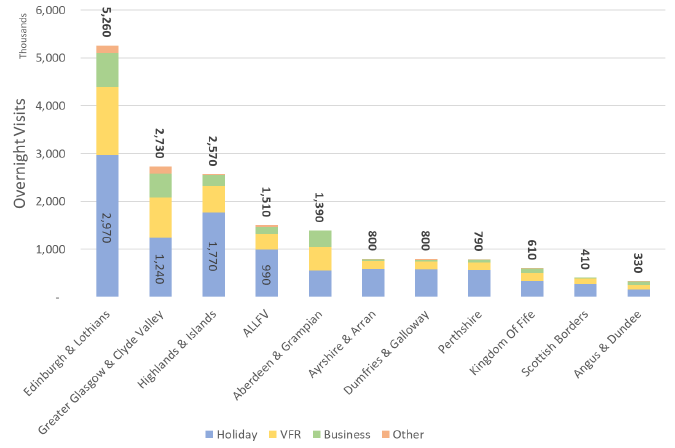
Source: IPS and GBTS (2019)[31]
Figure 4 shows that international overnight visitors are also relatively concentrated within Scotland. Edinburgh and the Lothians received around 31 per cent of total overnight visitors, but a much higher 49 per cent of Scotland’s total international overnight visitors in 2018. International visitors also represented almost half (46 per cent) of total visitors to Edinburgh and the Lothians. Other areas had much lower shares of international visitors with only Greater Glasgow and Clyde Valley (18 per cent) Highlands and Islands (12 per cent) having more than 10 per cent.
Figure 4: Domestic and International Overnight Visitors, 2018
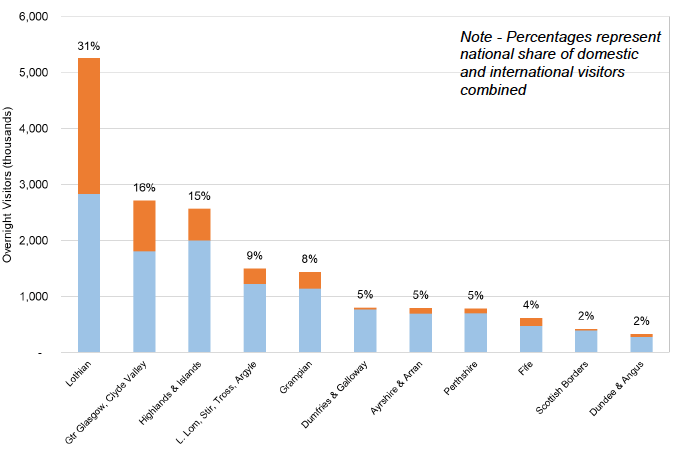
Source: IPS and GBTS (2018)
Day Visitors
Day visitors represent a significant source of tourism activity in Scotland. Scotland received an estimated 138 million day visits in 2018. Figure 5 shows that this represents a decrease of 13 million (8.7 per cent decrease) day visits since 2017. The overall number of day has remained relatively constant with an average of 147 million day visits per year between 2011 and 2018.
Figure 5: Day Visits to Scotland since 2011
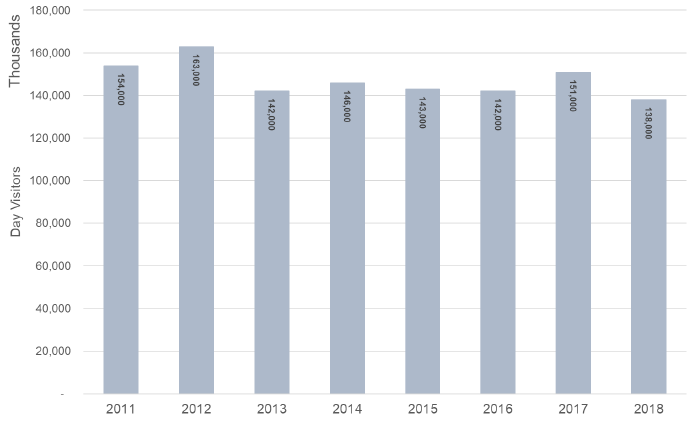
Source: ONS (2012 - 2018) Great Britain Day Visitor Survey
Figure 6 shows how many day visits each local authority area received in 2017. It highlights that the Glasgow and Edinburgh received the most day visitors of any authority, with an estimated 20 million day visitors each. Note that this is quite different to the distribution of overnight visitors where Edinburgh & the Lothians received the most visitors by some margin (see figure 3).
Figure 6: Day Visits across Scotland in 2017
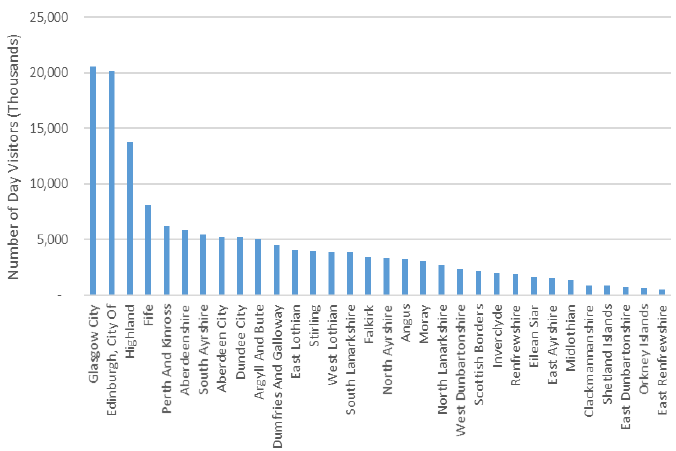
Source: ONS (2017) Great Britain Day Visitor Survey
Accommodation Sector
There are a range of different accommodation providers which offer visitors overnight accommodation on a commercial basis. These include hotels, guest houses, B&Bs, self-catered accommodation (both traditional and properties advertised through platforms such as Airbnb), hostels and campsites.
Accommodation providers are largely micro- or small businesses, with relatively small numbers of employees. Table 1 sets out registered business units within the accommodation sector by employee sizeband. These are business units that are registered to pay either VAT and / or PAYE.
Table 1: Accommodation, Registered Business Sites, by Employee Sizeband, 2018[32]
| 0-4 Employees |
5-9 Employees |
10-14 Employees |
15-49 Employees |
50+ Employees |
Total |
|
|---|---|---|---|---|---|---|
| Hotels and similar accommodation |
480 |
320 |
240 |
710 |
225 |
1,980 |
| Holiday and other short-stay accommodation |
635 |
125 |
35 |
35 |
5 |
840 |
| Camping grounds, recreational vehicle parks and trailer parks |
200 |
50 |
20 |
20 |
10 |
300 |
| Total |
1,320 |
495 |
295 |
765 |
240 |
3,120 |
Source: ONS (2018), Inter-Departmental Business Register
There are also a number of accommodation providers that do not currently generate turnover sufficient to exceed the VAT threshold. The Scottish Valuation Roll contains a list of all hotels, guest houses, hostels and most self-catered accommodation as these properties are rateable for non-domestic rates purposes (although many properties listed will benefit from relief so do not actually pay any business rates[33]). Table 2 shows the number of properties registered as at April 2019, by Scottish local authority area.
Table 2: Hotels, Guest Houses, B&Bs and Self-Catering Units on the valuation roll (as at April 2019)
|
|
Hotels |
Guest Houses / B&Bs |
Self-Catering Units |
|
Hotels |
Guest Houses/B&Bs |
Self-Catering Units |
|---|---|---|---|---|---|---|---|
| Aberdeen City |
260 |
90 |
30 |
Highland |
370 |
335 |
4,265 |
| Aberdeenshire |
175 |
55 |
570 |
Inverclyde |
5 |
- |
20 |
| Angus |
40 |
15 |
205 |
Midlothian |
10 |
10 |
45 |
| Argyll & Bute |
175 |
170 |
1,970 |
Moray |
90 |
15 |
410 |
| Clackmannanshire |
10 |
- |
30 |
North Ayrshire |
40 |
40 |
460 |
| Dumfries & Galloway |
160 |
65 |
1,265 |
North Lanarkshire |
25 |
10 |
30 |
| Dundee City |
35 |
20 |
50 |
Orkney Islands |
35 |
20 |
400 |
| East Ayrshire |
20 |
5 |
25 |
Perth & Kinross |
130 |
85 |
990 |
| East Dunbartonshire |
5 |
- |
10 |
Renfrewshire |
15 |
5 |
30 |
| East Lothian |
30 |
20 |
215 |
Scottish Borders |
85 |
40 |
670 |
| East Renfrewshire |
5 |
- |
10 |
Shetland Islands |
20 |
15 |
265 |
| Edinburgh, City of |
185 |
215 |
1,555 |
South Ayrshire |
55 |
30 |
250 |
| Eilean Siar |
30 |
25 |
590 |
South Lanarkshire |
35 |
10 |
80 |
| Falkirk |
35 |
5 |
60 |
Stirling |
90 |
55 |
465 |
| Fife |
115 |
65 |
575 |
W. Dunbartonshire |
15 |
10 |
60 |
| Glasgow City |
80 |
35 |
215 |
West Lothian |
30 |
10 |
45 |
| Total |
2,380 |
1,465 |
15,815 |
*All figures rounded to the nearest 5 properties
Data from STR[34] for July 2019 indicates there were around 2,100 hotels in Scotland, with a total room stock of around 75,000 rooms. Full year data for 2018 suggests that the overall room occupancy rate across Scotland’s hotels was just under 77 per cent. It should be noted that the number of hotels and room stock varies significantly across different regions and local authority areas.
VisitScotland’s Occupancy Survey provides information on occupancy rates across a range of accommodation types, including hotels, B&Bs and Guest Houses, Self-Catering accommodation, hostel accommodation, and caravan pitches. Figure 6 illustrates that occupancy rates vary across these accommodation types:
Figure 6: Occupancy Rate by Accommodation Type, Scotland, 2018
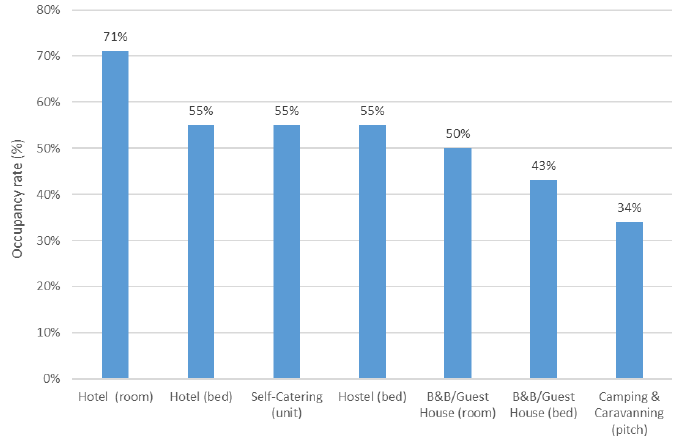
Source: VisitScotland Occupancy Survey
At a Scotland level, occupancy rates for hotel rooms and beds declined between 2017 and 2018, by 2.7 per cent and 3.5 per cent respectively. However, rates were unchanged for B&Bs and Guesthouses, and rates increased for Self-Catering units (by 3.8 per cent).
Occupancy rates also vary across Scotland for each accommodation type. For instance, Hotel Room occupancy rates ranged from 82 per cent in Glasgow & the Clyde Valley to 31 per cent in the Scottish Borders. B&B and Guest House room occupancy rates ranged from 68 per cent in Edinburgh and the Lothians to 24 per cent in Greater Glasgow and the Clyde Valley, while Self Catering unit occupancy rates ranged from 64 per cent in Argyll, Loch Lomond and the Forth Valley to 31 per cent in Shetland.
Contact
Email: TVLC@gov.scot
There is a problem
Thanks for your feedback